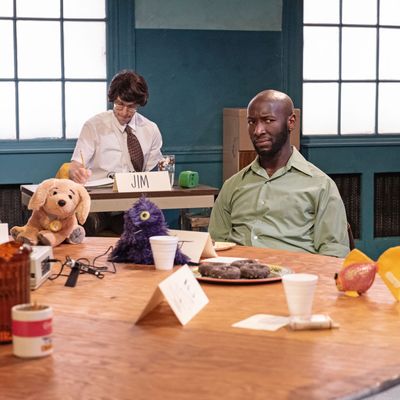
A year and change ago, I reviewed Miles for Mary, a needlepoint-meticulous study of miscommunication by the collaborative theater company the Mad Ones, and I left feeling impressed but a little underfed. The Mad Ones, who’ve got four artistic directors and an associate director, surely know of what they speak as they craft their detailed, cringy-funny anti-dramas about group dynamics, human ego and awkwardness, and the mundane, harrowing travails of consensus by committee — and yet for me, Miles ultimately felt like an exercise in a certain kind of virtuosity, rich in the means department and thinner when it came to the ends. The company’s latest project, Mrs. Murray’s Menagerie (they seem to have a thing for the letter M), makes a deeper impact with a lighter touch. It’s delicate and refreshingly anticlimactic, very funny but joke-free, a seemingly unassuming but pointed example of the kind of painstaking group character study that the company has marked as its turf.
Four-fifths of the Mad Ones’ leadership team takes the stage in Mrs. Murray, while the show’s director, Lila Neugebauer, guides from the outside with her characteristic understatement and precision. It’s the 1970s, and the fictional children’s TV program that lends its name to the play has arranged a focus group for the parents whose kids make up its target demographic. Bewigged with perms and bangs (by Alfreda “Fre” Howard) and surrounded by analog technology, coffee, and donuts, the actors gather around a table — a group of hesitant, well-meaning strangers who’ve been offered a few dollars for their opinions. All of the show’s eight performers are credited as its co-creators, and one of the chief delights of the Mad Ones’ work lies in watching a group of empowered actors. These are performers with agency and with secrets. What did Jim (Marc Bovino) — the quiet, put-upon assistant to Dale (Brad Heberlee), the focus group’s upbeat, conflict-averse coordinator — do to his arm, which hangs useless in a sling and makes it hilariously difficult for him to keep up as Dale spouts endless adjectives for him to write on the chalkboard? What’s up between Ernest (Phillip James Brannon) and his wife? (“Sometimes I think I married the wrong sister,” he jokes flatly. No one comments.) What’s haunting the tense, opinionated but easily cowed Gloria (Stephanie Wright Thompson)?
It’s the unanswered questions and implications, the mountain of what goes unsaid, that give dimension to Mrs. Murray’s premise. These people are here to do a simple job — answer some questions about their kids’ favorite television show — and technically, that’s all that happens. But every actor is sitting on top of a deep well of character work, and every sideways glance, every evasion, every poorly disguised bout of frustration, indignation, judgment, or self-consciousness is a bucket drawn up from that well. Ernest and Gloria — along with the glib, self-satisfied Roger (Joe Curnutte) and the prim, pampering June (Carmen M. Herlihy), the elegant, officious Celeste (January LaVoy) and the blunt, close-mouthed Wayne (Michael Dalto) — are only talking about a kindly imaginary woman and her family of puppets — but under the surface, aspersions are cast, offense is taken, prejudices and privilege reveal themselves, and alliances form and dissolve.
Miles for Mary took place in the late 1980s, and Mrs. Murray winds the clock back one more decade. The Mad Ones are committed to examining “American nostalgia,” but it strikes me that their interest in our predigital past is also an interest in poking at a time when we hadn’t yet defined the vocabulary for certain insidious strains of political and personal discomfort. “Privilege”, “problematic”, “microagression”, “mansplaining” — the characters of Mrs. Murray, who are taking puppets very personally, don’t have this language, and that’s a good thing. Ours is an age of charged shorthand, of quickfire terms that immediately open up a world of hurt and often preclude nuanced analysis. When Curnutte’s complacent, fragile Roger — offended by Gloria and brooding ostentatiously — threatens to scuttle the group’s goodwill, or when he laughingly, condescendingly touches Celeste’s leg, we could rush to diagnose his toxic masculinity … or, because the play itself exists in a world that predates such discourse, we could — and should — get more deliberate with our terms. Roger’s insufferable, yes, but how is he insufferable? He’s an egotist who thinks he’s a rationalist, a child who thinks he’s an adult, a snob who thinks he’s an everyman. We might have any number of expeditious terms for him, but it’s his moment-by-moment specificity that makes for interesting theater.
In a recent Times profile of Taylor Mac, the self-professed maximalist asserted that onstage, “subtlety is a privilege” — and although I understand his point, I’m not sure I entirely agree. Nothing blows up in Mrs. Murray’s Menagerie. Tensions of class and race and gender bubble under the surface without boiling over, but, in the words of the Magnetic Fields’ Stephin Merritt, “You can’t use a bulldozer to study orchids.” There’s something both humane and shrewd about the Mad Ones’ project, and in Mrs. Murray, they tread lightly, but they know right where they’re going.
Mrs. Murray’s Menagerie is at Ars Nova at Greenwich House through April 27.





